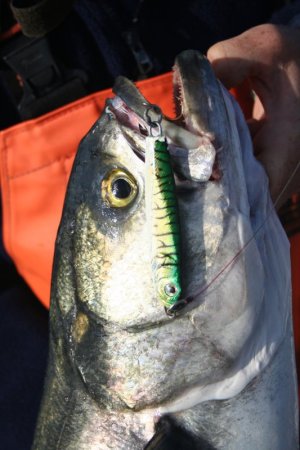I have noticed over the years that fishermen can’t wait to get out on the water in the spring when the fish are still way to our south and the water is cold. But come September when the mullet start running down the beach, the big flounder move offshore, the sea bass school up, and the bluefish and stripers begin to run south, fishermen go on to other pursuits. I know hunting takes up some of their time, and then there are school activities like football, hockey and such, but come on, there are big fish to be caught, unlike summer when a 1-pound king or croaker is cause for celebration.
Surf fishing
There will be a run of big blues and striped bass along the Delaware coast before the year is over. The blues will come first. They will be after mullet. And when they herd a school to the beach, it will be Katy, bar the door! The action will be hot and heavy.
Now is the time to break out the metal, and you can’t beat a Hopkins or a Stingsilver. Rig them up behind a shock leader of 40- or 50-pound fluorocarbon. We used to use wire, but that’s not necessary, as with a metal lure, the fish’s teeth should not get near the line. You can use cut mullet if no fish are showing.
Stripers will usually be on bunker or sand eels. Cut bunker is good, but AVA jigs are excellent when the stripers are on sand eels. Cast the jigs out from the beach and work them back with a jerky motion. From a boat, move the jig up and down off the bottom, trying to create a puff of sand with each upward movement of the jig. If you don’t feel the jig hit bottom, set the hook!
Surface lures can be an exciting way to catch blues and stripers. Most top-water plugs cast well and create quite a commotion on the water. Pick out a few like a pencil popper or any of the many other models that work across the surface of the water. The idea is to create the action of a wounded baitfish and draw the attention of any striper or bluefish in the neighborhood.
Boat fishing
Your choices open up when you fish from a boat. Blues and stripers, of course, but also black sea bass, summer flounder, triggerfish and porgies.
Trolling enters the picture when you have a boat. This technique is an excellent way to locate blues and stripers when they are not showing on the surface.
For stripers, I like to pull plugs. Rebels, YO-ZURI or RAPALA, whatever your heart desires. You must keep an eye on the rod tips. They should vibrate at all times. If the vibration stops, the plug is fouled and must be pulled in and cleaned off.
I try to avoid plugs for blues. Too many treble hooks. Single-hook lures will catch all the blues in the ocean. Drone spoons have always worked for me. Pull them slow so they don’t spin.
The late-season hot spot for sea bass has been the Del-Jersey-Land Reef. I fished there last December and caught my 15-fish limit. Plus, for the first time in my long and storied career, I won the pool. I was on a 10-hour trip aboard the Angler out of Ocean City, Md.
On a more recent trip, Oct. 26, aboard the same boat, we did not fish at the Del-Jersey-Land Reef. Instead, we worked an area where commercial sea bass pots were set. The fishing was good, but not as hot as we had it at Del-Jersey-Land the previous year. There was more variety, as I caught a triggerfish and a bluefish, while my son Ric caught a bluefish. We both caught a small flounder. A much larger flounder won the pool. I plan to return in December.
Indian River Inlet
The Indian River Inlet is one of the few places you can fish when all others are weathered out. If it’s stripers you are after, nighttime is the best time, and live eels are your friends. Fish the eels like you would a lure. Cast them out and retrieve them using the current to keep the eel from balling up.
Tog will be the other fish you will find at the inlet. Sand fleas and green crab, as well as shrimp, can be used for bait. Try to keep your line at a 90-degree angle to the water to reduce tackle loss. I only use a one-hook rig for the same reason.
Blues may show up at any time. Keep a couple of metal lures handy just in case.
























































